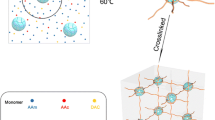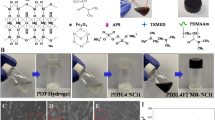Abstract
Temperature-sensitive hydrogels with high mechanical strength are widely used in biomedical and environmental fields. In this work, a series of high-strength temperature-sensitive composite hydrogels, i.e., laponite-modified poly(acrylamide-co–N-vinylcaprolactam) [poly(AM-co-NVCL)] were prepared by aqueous solution polymerization and characterized by Fourier-transform infrared (FTIR), thermogravimetric (TG-DTG), X-ray diffraction (XRD) and scanning electron microscope (SEM) techniques. The swelling kinetic showed that the swelling ratio of the gels increased rapidly in the first 120 min, and then the increase slowed down. All samples reached swelling equilibrium after 1000 min. The equilibrium swelling ratio of the composite hydrogels was affected by the monomers ratio and amount of laponite. When AM:NVCL = 1:1 and the dosage of laponite was 10 wt%, the swelling ratio of the composite hydrogel was the highest, which was 594 g/g. The compressive strength of the composite hydrogels increased while the elongation-at-break values increased first and then decreased with the increase of laponite content. The hydrogel with 15 wt% laponite has the best comprehensive mechanical properties. Its elongation-at-break value was 820%, and compressive strength was 48.83 MPa. The volume phase transition of the composite hydrogels occurred at 30.1–35 °C. SEM micrographs showed that the number of pores in the gels increased with the addition of laponite but the pore size decreased.
Graphical abstract









Similar content being viewed by others
Data availability
The data that support the findings of this study are available from the corresponding author upon reasonable request.
References
Du H, Liu W, Zhang M, Si C, Zhang X, Li B (2019) Cellulose nanocrystals and cellulose nanofibrils based hydrogels for biomedical applications. Carbohydr Polym 209:130–144
George D, Maheswari PU, Begum KMMS (2019) Synergic formulation of onion peel quercetin loaded chitosan-cellulose hydrogel with green zinc oxide nanoparticles towards controlled release, biocompatibility, antimicrobial and anticancer activity. Int J Biol Macromol 132:784–794
Wang L, Cheng W, Wan T, Hu Z, Li R, Zou C (2015) Synthesis and properties of hectorite/poly(AM/IA) nanocomposite hydrogels with high gel strength. J Chem Sci 127:19–23
Ghosh T, Katiyar V (2019) Cellulose-based superabsorbent hydrogels. In: Mondal MIH (ed) Polymers and polymeric composites: a reference series. Springer, Cham
Sarkar DJ, Singh A (2019) pH-triggered release of boron and thiamethoxam from boric acid crosslinked carboxymethyl cellulose hydrogel based formulations. Polym Plast Technol Eng 58:83–96
Jeddi MK, Mahkam M (2019) Magnetic nano carboxymethyl cellulose-alginate/chitosan hydrogel beads as biodegradable devices for controlled drug delivery. Int J Biol Macromol 135:829–838
Kelly JA, Shukaliak AM, Cheung CCY, Shoposowitz KE, Hamad WY, MacLachlan MJ (2013) Responsive photonic hydrogels based on nanocrystalline cellulose. J Angewandte Chemie 52:8912–8916
Sanna R, Fortunati E, Alzari V, Nuvoli D, Terenzi A, Casula MF, Kenny JM, Mariani A (2013) Poly(N-vinylcaprolactam) nanocomposites containing nanocrystalline cellulose: a green approach to thermoresponsive hydrogels. Cellulose 20:2393–2402
Dai H, Zhang H, Ma L, Zhou H, Yu Y, Guo T, Zhang Y, Huang H (2019) Green pH/magnetic sensitive hydrogels based on pineapple peel cellulose and polyvinyl alcohol: synthesis, characterization and naringin prolonged release. Carbohydr Polym 209:51–61
Sun X, Tyagi P, Agate S, Lucia L, Mccord M, Pal L (2019) Unique thermo-responsivity and tunable optical performance of poly(N-isopropylacrylamide)-cellulose nanocrystal hydrogel films. Carbohydr Polym 208:495–503
Chen YC, Chen YH (2019) Thermo and pH-responsive methylcellulose and hydroxypropyl methylcellulose hydrogels containing K2SO4 for water retention and a controlled-release water-soluble fertilizer. Sci Total Environ 655:958–967
Li Y, Qin J, Bao H, Han Y, Zeng X, Zheng H, Huang Y, Xia X, Dong Z, Hu R, Liu Y (2018) Controlled tuning of LCST based on poly (N-isopropylacrylamide)/hydroxypropyl cellulose temperature-sensitive hydrogel by electron beam pre-radiation method. J Polym Res 25:19
Pan Y, Wang J, Cai P, Xiao H (2018) Dual-responsive IPN hydrogel based on sugarcane bagasse cellulose as drug carrier. Int J Biol Macromol 118(Part A):132–140
Li Y, Xiao H, Pan Y, Zhang M, Jin Y (2019) Thermal and pH dual-responsive cellulose microfilament spheres for dye removal in single and binary systems. J Hazard Mater 377:88–97
Grishkewich N, Akhlaghi SP, Yao Z, Berry R, Tam KC (2016) Cellulose nanocrystal-poly (oligo (ethylene glycol) methacrylate) brushes with tunable LCSTs. Carbohydr Polym 144:215–222
Gau E, Flecken F, Ksiazkiewicz AN, Pich A (2017) Enzymatic synthesis of temperature-responsive poly(N-vinylcaprolactam) microgels with glucose oxidase. Green Chem 20:431–439
Zhang J, Wu Q, Li MC, Song K, Sun X, Lee SY, Lei T (2017) Thermoresponsive copolymer poly(N-vinylcaprolactam) grafted cellulose nanocrystals: synthesis, structure, and properties. ACS Sustain Chem Eng 5:7439–7447
Winninger J, Iurea DM, Atanse LI, Salhi S, Delaite C, Riess G (2019) Micellization of novel biocompatible thermo-sensitive graft copolymers based on poly(ε-caprolactone), poly(N-vinylcaprolactam) and poly(N-vinylpyrrolidone). Eur Polym J 119:74–82
Imaz A, Forcada J (2009) Optimized buffered polymerizations to produce N-vinylcaprolactam-based microgels. Eur Polym J 45:3164–3175
Makhaeva EE, Thanh LTM, Starodoubtsev SG, Khokhlov AR (1996) Thermoshrinking behavior of poly(vinylcaprolactam) gels in aqueous solution. Macromol Chem Phys 197:1973–1982
Shi K, Liu Z, Yang C, Li XY, Sun YM, Deng Y, Wang W, Ju XJ, Xie R, Chu LY (2017) Novel biocompatible thermo-responsive poly(N-vinyl caprolactam)/clay nanocomposite hydrogels with macroporous structure and improved mechanical characteristics. Acs Appl Mater Interfaces 9:21979–21990
Arellano-Sandoval L, Delgado E, Camacho-Villegas TA, Bravo-Madrigal J, Manriquez-González R, Lugo-Fabres H, Toriz G, García-Uriostegui L (2020) Development of thermosensitive hybrid hydrogels based on xylan-type hemicellulose from agave bagasse: characterization and antibacterial activity. MRS Commun 10:147–154
Parameswaran-Thankam A, Parnell CM, Watanabe F, RanguMagar AB, Chhetri BP, Szwedo PK, Biris AS, Ghosh A (2018) Guar-based injectable thermoresponsive hydrogel as a scaffold for bone cell growth and controlled drug delivery. ACS Omega 3:15158–15167
Huang T (2012) P(NIPAM-co-AA)/clay nanocomposite hydrogels exhibiting high swelling ratio accompanied by excellent mechanical strength. Appl Phys A Mater Sci Process 107:905–909
Chen Z, Tang J, Zhang N, Chen Y, Chen Y, Li H, Liu H (2022) Dual-network sodium alginate/polyacrylamide/laponite nanocomposite hydrogels with high toughness and cyclic mechano-responsiveness. Colloids Surf A Physicochem Eng. https://doi.org/10.1016/j.colsurfa.2021.127867
Du Z, Hu Y, Gu X, Hu M, Wang C (2016) Poly(acrylamide) microgel-reinforced poly(acrylamide)/hectorite nanocomposite hydrogels. Colloids Surf A Physicochem Eng 489:1–8
Yang X, Li Z, Liu H, Ma L, Huang X, Cai Z, Xu X, Shang S, Song Z (2020) Cellulose-based polymeric emulsifier stabilized poly(N-vinylcaprolactam) hydrogel with temperature and pH responsiveness. Int J Biol Macromol 143:190–199
Ma JH, Tang YC, Liang B-R (2007) Study on the preparation and swelling behaviors of poly(N-isopropylacrylamide)/clay nanocomposite hydrogel. J Donghua Univ (Natur Sci Ed) 33:692–695
Büyükbektş A, Delibaş A, Benk A, Coşkun R (2021) Laponite-AMPS/AA composite hydrogels for efficient removal of methylene blue (MB). J Polym Res 28:307
Li XW (2010) Synthesis of silk glue-based semi-interpenetrating temperature-sensitive hydrogels and their cytocompatibility. D Tianjin University of Technology. https://doi.org/10.7666/d.y1879085
Huan Z (2009) Basic research on the rheological properties of synthetic hydrogels and related biomaterials. D Fudan University.
Yang B, Wang C, Zhang Y, Ye L, Qian Y, Shu Y, Wang J, Li J, Yao F (2015) A thermoresponsive poly(N-vinylcaprolactam-co-sulfobetaine methacrylate) zwitterionic hydrogel exhibiting switchable anti-biofouling and cytocompatibility. Polym Chem 6:3431–3442
Xiancai R (2021) Preparation of temperature-sensitive hydrogels and their properties. Coal Sci Technol S02:049
Jiangju S, Changyong Y, Shun L (2022) Preparation and performance characterization of temperature-sensitive hydrogel poly-N-isopropylacrylamide. J Polymer Bulletin 09:60–65
Funding
The authors gratefully acknowledge the support of the Science and Technology Planning Project of Tianjin [Grant number 22YDTPJC00590].
Author information
Authors and Affiliations
Contributions
BZ: Supervision, Resources, Conceptualization, Writing-review & editing. YY: Visualization, Formal analysis, Investigation, Writing-original draft. HZ: Writing-review & editing. XL: Formal analysis. HX: Writing-original draft.
Corresponding authors
Ethics declarations
Conflict of interest
The authors report no declarations of interest.
Rights and permissions
Springer Nature or its licensor (e.g. a society or other partner) holds exclusive rights to this article under a publishing agreement with the author(s) or other rightsholder(s); author self-archiving of the accepted manuscript version of this article is solely governed by the terms of such publishing agreement and applicable law.
About this article
Cite this article
Yuan, Y., Zhang, B., Zhao, H. et al. Preparation and performance of poly(AM/NVCL) temperature-sensitive composite hydrogels enhanced by laponite. Iran Polym J 33, 555–565 (2024). https://doi.org/10.1007/s13726-023-01265-7
Received:
Accepted:
Published:
Issue Date:
DOI: https://doi.org/10.1007/s13726-023-01265-7




